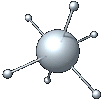CD-ROM for Mac/Windows, $39.00
Grades 5-8
distributed by Pierian Spring Software
5200 SW Macadam Ave., Portland, OR 97201
info@pierian.com
www.pierian.com
A notebook that is accessible from each of the activity stations allows students to keep records of their work as they explore the building. It contains worksheets for each of the activities, a calculator, and an extensive glossary of scientific terms relating to the topics covered. Each entry includes the term's definition, a picture, and guidelines for pronunciation.
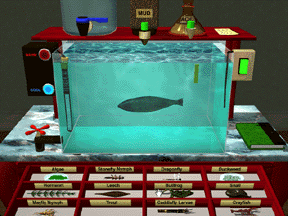 In terms of their visual language and interface functions, the four activity stations appear to stand by themselves. At "The Aquarium," students pick any of a dozen living organisms from a tray (e.g. trout, bullfrog, dragonfly, algae, crayfish) and immerse them into a freshwater environment. They can create the environment of the tank by operating spigots and switches that change temperature, acidity, turbidity, and oxygen levels inside the tank. As they drop organisms into the tank, users may observe which of them thrive or perish in a specific environment. The sound that the poor critters make when they fall back onto the tray (after having been placed into an environment harmful to them) will probably make a lasting impression and effectively teach students that, for example, bullfrogs and acid don't match. The aquarium's interface and features are easy to comprehend and use so that students can explore the station without feeling lost or having to consult the help tool.
In terms of their visual language and interface functions, the four activity stations appear to stand by themselves. At "The Aquarium," students pick any of a dozen living organisms from a tray (e.g. trout, bullfrog, dragonfly, algae, crayfish) and immerse them into a freshwater environment. They can create the environment of the tank by operating spigots and switches that change temperature, acidity, turbidity, and oxygen levels inside the tank. As they drop organisms into the tank, users may observe which of them thrive or perish in a specific environment. The sound that the poor critters make when they fall back onto the tray (after having been placed into an environment harmful to them) will probably make a lasting impression and effectively teach students that, for example, bullfrogs and acid don't match. The aquarium's interface and features are easy to comprehend and use so that students can explore the station without feeling lost or having to consult the help tool.
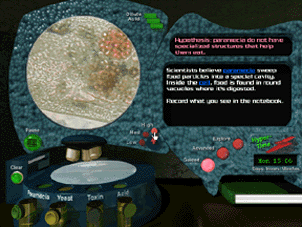
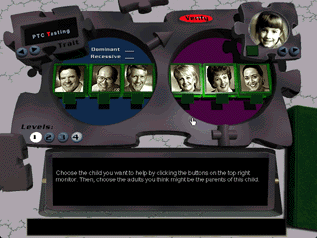
Of the two game-oriented activity stations, "Genes and Traits" is the one that may require a little "Help" with the interface and its functions but it has more to offer in terms of educational value. Players become "genetic detectives" whose task it is to help four children find their parents by using inherited traits as clues. The main activity screen for "Genes and Traits" consists of a control panel that enables students to select a child and match it with its parents by comparing gene pairs for a given trait. The different activity levels present information about genes and chromosomes; and the traits that may be investigated include cleft chin, attached earlobes, and baldness.
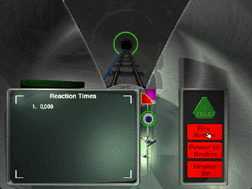 "The Nerve Express" is easier to play than "Genes and Traits" but may be of greater entertainment than educational value. The game simulates the experience of sitting in the engineer's booth of a speeding express train and asks you to use a three-step brake when a red light appears in the tunnel. Players can evaluate their reaction time when they are fully alert or under the simulated effect of drinking alcohol--which simply means that the cursor seems to be slightly out of control and "reacts" much slower to any kind of navigation. Students may also view a video that describes how nerves transmit electrical impulses and play the neurotransmitter game, where they can observe the transmission of nerve signals (under normal and alcohol-affected conditions) by dragging neurotransmitters to receptors. The activity station may be successful in providing students with a general understanding of
how a behavioral response requires coordination and communication at many levels. If the students realize how alcohol or drugs change how the body functions remains debatable; above all, "The Nerve Express" effectively illustrates the value of faster hardware.
"The Nerve Express" is easier to play than "Genes and Traits" but may be of greater entertainment than educational value. The game simulates the experience of sitting in the engineer's booth of a speeding express train and asks you to use a three-step brake when a red light appears in the tunnel. Players can evaluate their reaction time when they are fully alert or under the simulated effect of drinking alcohol--which simply means that the cursor seems to be slightly out of control and "reacts" much slower to any kind of navigation. Students may also view a video that describes how nerves transmit electrical impulses and play the neurotransmitter game, where they can observe the transmission of nerve signals (under normal and alcohol-affected conditions) by dragging neurotransmitters to receptors. The activity station may be successful in providing students with a general understanding of
how a behavioral response requires coordination and communication at many levels. If the students realize how alcohol or drugs change how the body functions remains debatable; above all, "The Nerve Express" effectively illustrates the value of faster hardware.
Translated into alcohol, the difference between playing the game on a fast or slow computer feels like the degree of impairment induced by effect of let's say two glasses of wine or a bottle of Tequila. It's easy to forget all about nerves and to become obsessed with trying to beat the machine and getting the "normal" reaction time under "alcohol-affected" conditions.
The "Living Science" CD-ROM aligns with the National Science Education Standards for grades 5-8. Published in 1996, these standards encourage an inquiry-based approach to science education. They suggest that students participate actively in learning and that students should learn by doing. The CD-ROM appears to be quite effective in employing interactive instruction to capture and hold the attention of the learners. The degree to which it hones the users' critical thinking skills as they collect, manipulate, analyze and interpret data varies from station to station. One problem with "Living Science" might be that it uses the image of a hall of science which tends to give users the impression of visiting a museum rather than navigating a universe of organisms and phenomena that are joined by a "connective tissue." The link between the activity stations and the scientific realms they teach about may seem a little hazy or too "Mysty."
© Hyperactive Co. 1998
